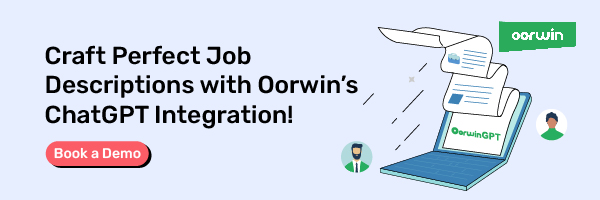Understanding Recruiting Technology for Candidate Experience
Oorwin
2min read / 29 Dec 2023

Related Articles
How Recruitment Technology Can Enhance Candidate Experience
Recruitment technology is revolutionizing the hiring landscape, significantly impacting how companies attract, engage, and retain talent. This blog explores the essence of recruitment technology, its benefits, key factors in selecting the right tools, leading technologies in 2024, best practices for implementation, and future trends in this dynamic field.
Meaning of Recruitment Technology
Recruitment technology encompasses various tools and platforms designed to automate and improve the hiring process. From sourcing candidates to finalizing hires, these technologies integrate advanced algorithms, artificial intelligence, and digital solutions, streamlining recruitment tasks, enhancing accuracy, and fostering better candidate engagement. They are pivotal in transforming traditional, manual recruitment methods into efficient, data-driven processes, ensuring companies find the right talent while providing a positive experience for job seekers.
Major Benefits of Utilizing Recruitment Technology
Embracing recruitment technology offers various benefits, significantly elevating the hiring process’s effectiveness and efficiency.
Boosts Hiring Efficiency
Recruitment technology accelerates hiring, automating routine tasks like resume screening and interview scheduling. This increased speed enables recruiters to focus on strategic aspects, like candidate engagement and decision-making, reducing the time-to-hire and improving the overall recruitment productivity.
Enhances Job Seeker Experience
By utilizing user-friendly platforms and automated communication tools, recruitment technology offers job seekers a seamless, engaging experience. Features like chatbots like ChatGPT and AI-driven interfaces provide timely responses and personalized interaction, making the application process more transparent and less intimidating for candidates.
Broadens Candidate Reach
Advanced recruitment technologies extend a company’s reach to a global talent pool. Online job postings, social media integration, and virtual career fairs make connecting with diverse candidates from various geographical locations, backgrounds, and skill sets easier, fostering a more inclusive recruitment process.
Gaining Valuable Insights from Recruitment Data
Recruitment technology enables the collection and analysis of extensive hiring data. These insights help understand recruitment trends, candidate preferences, and process bottlenecks. This data-driven approach aids in making informed decisions, fine-tuning recruitment strategies, and identifying areas for improvement.
Reducing Costs in the Hiring Process
Automating repetitive tasks and optimizing recruitment strategies, technology significantly cuts down hiring expenses. Reduced administrative workload, lower advertising costs, and minimized need for external recruitment agencies contribute to substantial cost savings, making the process more budget-friendly and efficient.
Important Factors in Selecting Recruitment Technology
Choosing the right recruitment technology requires careful consideration of several crucial factors to ensure it aligns with organizational needs.
Ensure Compatibility with Your Recruitment Plan
The selected technology should seamlessly integrate with your overall recruitment strategy. It must support your objectives, whether improving candidate quality, reducing hiring time, or enhancing candidate engagement. Ensure the technology aligns with your long-term recruitment goals and can adapt to evolving hiring needs.
Assessing the User-Friendliness of the Platform
A user-friendly recruitment platform is essential for both recruiters and candidates. It should have an intuitive interface, easy navigation, and straightforward processes. This ensures that all users can efficiently utilize the platform without extensive training or technical support, enhancing the overall recruitment experience.
Examining the Customer Support Level
Adequate customer support is crucial for addressing technical issues and ensuring smooth operation. Assess the support services offered, including response time, availability, and the quality of assistance. Strong customer support guarantees that any challenges encountered with the technology are promptly and effectively resolved.
Assessing Targeting Specific Candidate Groups
The technology should have the capability to target specific candidate groups based on skills, experience, and other relevant criteria. This targeted approach ensures you reach the most suitable candidates, increasing the likelihood of finding the right fit for your organization.
Ensuring Compatibility with Current HR Tools
Integration with existing HR systems is vital for a streamlined workflow. The recruitment technology should seamlessly integrate with your HR software, payroll systems, and other related tools. This compatibility ensures a unified talent management approach and minimizes existing process disruptions.
Evaluating Cost-Effectiveness
Consider the return on investment when selecting recruitment technology. Analyze the costs involved against the benefits it offers, such as time savings, improved candidate quality, and reduced hiring costs. A cost-effective solution will provide substantial value without straining your recruitment budget.
Analyzing Data Analytics Features in Recruitment Tech
Data analytics capabilities are a key feature of modern recruitment technology. Evaluate the robustness of the platform’s analytics tools, including their ability to track performance metrics, analyze hiring trends, and provide actionable insights. Effective data analytics aids in refining recruitment strategies and making data-driven decisions.
Top 8 Recruitment Technology Tools in 2024
2024 has seen innovative recruitment technology tools emerge, each playing a pivotal role in modernizing the hiring process.
Applicant Tracking Systems (ATS)
ATS has become indispensable in managing the recruitment lifecycle. They automate the tracking of applications, streamline candidate communication, and provide organized databases for easy retrieval of candidate information. These systems enhance efficiency and organization, making them a cornerstone in recruitment technology.
Video Interviewing Software
Video interviewing software facilitates remote video interviews, offering convenience and flexibility. It allows recruiters to conduct live or pre-recorded interviews, expanding their ability to connect with candidates regardless of geographical constraints. This tool is essential in a world increasingly leaning towards remote work and global talent pools.
Onboarding Software
Onboarding software streamlines the process of integrating new hires into the company. It automates paperwork, provides training resources, and establishes clear communication channels, ensuring a smooth and engaging onboarding experience. This technology is crucial in building a positive first impression and setting the stage for long-term employee engagement.
Employee Referral Software
Employee referral software optimizes the referral process, making it easier for employees to refer candidates and track the status of their referrals. This tool leverages existing employees’ networks, often leading to higher-quality candidates and faster hiring times while boosting employee engagement and retention.
Automated Resume Screening
Automated resume screening uses AI to evaluate efficiently and shortlist candidates based on predefined criteria. This technology significantly reduces the time spent on manual resume review, ensuring only the most relevant candidates move forward in the hiring process. It’s a powerful tool for managing large volumes of applications and improving the quality of hires.
AI-Powered Candidate Matching
AI-powered candidate matching tools use machine learning algorithms to match job requirements with candidate profiles. These tools analyze skills, experience, and other relevant attributes to identify the best-suited candidates, enhancing the precision and effectiveness of the recruitment process.
Recruitment Chatbots
Recruitment chatbots provide real-time interaction with candidates, answering queries, scheduling interviews, and offering personalized updates. These AI-driven bots improve candidate engagement, reduce response times, and free up recruiters to focus on more strategic tasks, making them valuable in the recruitment toolkit.
Recruitment CRM Systems
Recruitment CRM (Customer Relationship Management) systems help manage and nurture candidate relationships, fostering a talent pipeline for future needs. These systems track candidate interactions, preferences, and history, enabling personalized communication and engagement strategies. They are essential for building a strong employer brand and ensuring a continuous flow of quality candidates.
Best Practices for Implementing Recruitment Technology
Successfully implementing recruitment technology involves strategic planning and best practices to maximize benefits.
- Understand Recruitment Needs and Objectives: Clearly define your recruitment goals and needs. This understanding guides the selection of technology that aligns with your specific organizational objectives, ensuring it adds value to your recruitment process.
- Secure Stakeholder Involvement and Buy-In: Engage and involve stakeholders from various departments early in the process. Their support and input are crucial for smooth adoption and integration of the new technology into existing systems and processes.
- Comprehensive Training for Users: Offer in-depth training sessions to all users. This step is key to ensuring everyone is comfortable and proficient in using the new technology, essential for maximizing its benefits.
- Regularly Update Technology Stack: Stay ahead in the dynamic field of recruitment by routinely reviewing and updating your technology tools. This practice helps adapt to changing recruitment trends and maintain a competitive edge.
- Foster a Data-Driven Culture: Encourage using data and analytics in decision-making. A data-driven approach in recruitment leads to more informed strategies and continuous improvements in the hiring process.
- Prioritize Candidate Experience: Make the candidate experience a central consideration in every technology-related decision. This focus ensures a candidate-friendly recruitment process, enhancing your brand’s appeal to potential hires.
- Evaluate and Iterate Based on Feedback: Regularly assess the effectiveness of your recruitment technology and processes. Use feedback and data insights to make iterative improvements, ensuring your recruitment strategy remains efficient and effective.
Future Trends in Recruitment Technology
The future of recruitment technology is characterized by increasing personalization, AI-driven automation, and integration of virtual reality in candidate assessment. Predictive analytics will become more prevalent, offering deeper insights into candidate potential and fit. Enhanced focus on diversity and inclusion will drive the development of tools that minimize unconscious bias in hiring. Blockchain technology might be adopted to verify candidate credentials and ensure authenticity. Additionally, the rise of remote work will further amplify the need for virtual collaboration tools in recruitment, making the process more efficient and globally accessible.
Staying informed and adapting to these changes is key in this evolving landscape. For a recruitment solution that keeps pace with these trends and more, explore Oorwin – a platform designed to harness the power of cutting-edge technology to transform your recruitment experience.
FAQ
What Is Recruitment Technology and How Does It Work?
Recruitment technology encompasses digital tools and platforms designed to automate and streamline the hiring process, from sourcing candidates to finalizing hires, using algorithms and data analysis.
How Can Recruitment Technology Improve the Hiring Process?
Recruitment technology enhances hiring efficiency, improves candidate experience, broadens candidate reach, provides valuable data insights, and reduces hiring costs through automation and data-driven strategies.
What Should Organizations Consider When Implementing Recruitment Technology?
Organizations should consider their specific recruitment needs, ensure compatibility with existing HR tools, assess the technology’s user-friendliness, evaluate cost-effectiveness, and prioritize enhancing the candidate experience.
Popular Articles..
Blog

9min read / 25-Jun-2025
Master Effective Interview Techniques with Oorwin: A Step-by-Step Recruiter’s Guide
Blog
Blog
Get the latest Oorwin releases, updates, success stories & industry news
 Back
Back




